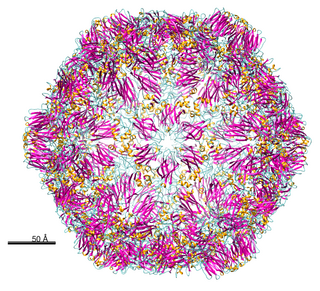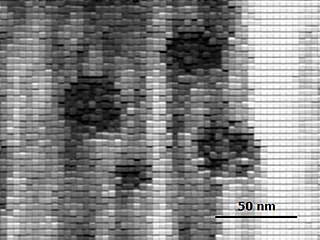
Dicistroviridae is a family of viruses in the order Picornavirales. Invertebrates, including aphids, leafhoppers, flies, bees, ants, and silkworms, serve as natural hosts. There are 15 species in this family, assigned to three genera. Diseases associated with this family include: DCV: increased reproductive potential. extremely pathogenic when injected with high associated mortality. CrPV: paralysis and death.
Sequivirus is a genus of viruses in the order Picornavirales, in the family Secoviridae. Plants serve as natural hosts. There are three species in this genus. Diseases associated with this genus include: PYFV: vein-yellowing, yellow flecks and yellow/green mosaic symptoms in parsnip, and ‘yellow net', followed by yellow spots and leaf distortion in celery.

Nepovirus is a genus of viruses in the order Picornavirales, in the family Secoviridae, in the subfamily Comovirinae. Plants serve as natural hosts. There are 40 species in this genus. Nepoviruses, unlike the other two genera in the subfamily Comovirinae, are transmitted by nematodes.

Marnaviridae is a family of positive-stranded RNA viruses in the order Picornavirales. The first species of this family that was isolated is Heterosigma akashiwo RNA virus (HaRNAV) in the genus Marnavirus, that infects the toxic bloom-forming Raphidophyte alga, Heterosigma akashiwo. Using a sequence-based framework an additional twenty marine RNA viruses have been added to the family.
Cheravirus is a genus of viruses in the order Picornavirales, in the family Secoviridae. Plants serve as natural hosts. There are five species in this genus.
Sadwavirus is a genus of viruses in the order Picornavirales, in the family Secoviridae. Plants serve as natural hosts. There are three subgenera and five species in this genus. Diseases associated with this genus include: satsuma dwarf virus disease which causes spoon-shaped leaves on citrus tree. Symptoms are enations, multiple flushing, stunting or dwarfing, reduction in number and size of leaves and fruits. The name of this genus comes from one of its species: Satsuma dwarf virus.
Endornaviridae is a family of viruses. Plants, fungi, and oomycetes serve as natural hosts. There are 31 species in this family, assigned to 2 genera. Members of Alphaendornavirus infect plants, fungi and the oomycete Phytophthora sp., members of Betaendornavirus infect ascomycete fungi.

Betaflexiviridae is a family of viruses in the order Tymovirales. Plants and fungi serve as natural hosts. There are 108 species in this family, assigned to 13 genera in two subfamilies. Diseases associated with this family include mosaic and ringspot symptoms.

Secoviridae is a family of viruses in the order Picornavirales. Plants serve as natural hosts. There are 8 genera and 86 species in this family, one of which is unassigned to a genus. The family was created in 2009 with the grouping of families Sequiviridae, now dissolved, and Comoviridae, now subfamily Comovirinae, along with the then unassigned genera Cheravirus, Sadwavirus, and Torradovirus.
Fabavirus is a genus of plant viruses in the order Picornavirales, in the family Secoviridae, in the subfamily Comovirinae. Plants serve as natural hosts. There are seven species in this genus.

Comovirus is a genus of viruses in the order Picornavirales, in the family Secoviridae, in the subfamily Comovirinae. Plants serve as natural hosts. There are 15 species in this genus.
Torradovirus is a genus of viruses in the order Picornavirales, in the family Secoviridae. Plants serve as natural hosts. There are six species in this genus. Diseases associated with this genus include: torrado disease: severe necrosis of leaves and fruits.
Waikavirus is a genus of viruses in the order Picornavirales, in the family Secoviridae. Plants, poaceae, cyperaceae, and gramineae serve as natural hosts. There are four species in this genus. Diseases associated with this genus include: MCDV: plant stunting and chlorotic striping of tertiary leaf veins in maize.
Avisivirus is a genus of viruses in the order Picornavirales, in the family Picornaviridae. Turkey serve as natural hosts. There are three species in this genus.
Dicipivirus is a genus of viruses in the order Picornavirales, in the family Picornaviridae. Dog serve as natural hosts. There are two species in this genus.
Gallivirus is a genus of viruses in the order Picornavirales, in the family Picornaviridae. Turkey and chicken serve as natural hosts. There is only one species in this genus: Gallivirus A.
Labyrnavirus is a monotypic genus of viruses in the order Picornavirales. Protist and labyrinthulomycetes serve as natural hosts, notably Aurantiochytrium. There is only one species in this genus: Aurantiochytrium single-stranded RNA virus 01.
Oscivirus is a genus of viruses in the order Picornavirales, in the family Picornaviridae. Birds serve as natural hosts. There is only one species in this genus: Oscivirus A.
Pasivirus is a genus of viruses in the order Picornavirales, in the family Picornaviridae. Pigs serve as natural hosts. There is only one species in this genus: Pasivirus A.
Rosavirus is a genus of viruses in the order Picornavirales, in the family Picornaviridae. Human and rodents serve as natural hosts. There are three species in this genus.





